Understanding Current and Future Fragmentation Dynamics of Urban Forest Cover in the Nanjing Laoshan Region of Jiangsu, China
Abstract
1. Introduction
2. Materials and Methods
2.1. Study Area
2.2. Satellite Data Preparation
2.3. Land Cover Mapping (2002–2017) with Object-Oriented Classification
2.4. Land Covers Prediction Modeling
2.5. Spatial Analysis of Observed and Predicted Forest Cover Change
2.6. Fragmentation Analysis of the Forest Cover Change Pattern
3. Results
3.1. Validation of Current and Future Land Cover Maps in the NLR
3.2. Spatial Patterns of Current and Future Forest Cover Change in the NLR
3.2.1. Analysis of the Landscape Change Pattern
3.2.2. Analysis of Forest Loss and Gain
3.3. Analysis and Variation of the FAD-Based Forest Fragmentation Data
3.3.1. FAD-Based Forest Fragmentation Data and its Variability
3.3.2. Detecting and Quantifying Changes of Forest Fragmentation
3.3.3. Estimation of the Multi-Source Data Impacts on Forest Fragmentation
3.4. Evaluation of Forest Fragmentation Dynamics Associated with Forest Changes
4. Discussion
4.1. Mapping Spatiotemporal Dynamics of Current and Future Forest Cover
4.2. Assessment of Forest Cover Change Detection Methods
4.3. Assessment of Variations in Forest Fragmentation over Time
4.4. Forest Cover Change and Effects on Forest Fragmentation
4.5. Uncertainties and Future Work
5. Conclusions
Supplementary Materials
Author Contributions
Funding
Acknowledgments
Conflicts of Interest
References
- Betts, M.G.; Wolf, C.; Ripple, W.J.; Phalan, B.; Millers, K.A.; Duarte, A.; Butchart, S.H.M.; Levi, T. Global forest loss disproportionately erodes biodiversity in intact landscapes. Nature 2017, 547, 441–444. [Google Scholar] [CrossRef] [PubMed]
- Liu, J.; Coomes, D.A.; Gibson, L.; Hu, G.; Liu, J.; Luo, Y.; Wu, C.; Yu, M. Forest fragmentation in China and its effect on biodiversity. Biol. Rev. 2019, 94, 1636–1657. [Google Scholar] [CrossRef] [PubMed]
- Gong, C.; Yu, S.; Joesting, H.; Chen, J. Determining socioeconomic drivers of urban forest fragmentation with historical remote sensing images. Landsc. Urban Plan 2013, 117, 57–65. [Google Scholar] [CrossRef]
- Kupfer, J.A. National assessments of forest fragmentation in the US. Glob. Environ. Chang. 2006, 16, 73–82. [Google Scholar] [CrossRef]
- MacDonald, K.; Rudel, T.K. Sprawl and forest cover: What is the relationship? Appl. Geogr. 2005, 25, 67–79. [Google Scholar] [CrossRef]
- Chazdon, R.L. Beyond deforestation: Restoring forests and ecosystem services on degraded lands. Science 2008, 320, 1458–1460. [Google Scholar] [CrossRef]
- McIntyre, S.; Hobbs, R. A framework for conceptualizing human effects on landscapes and its relevance to management and research models. Conserv. Biol. 1999, 13, 1282–1292. [Google Scholar] [CrossRef]
- Wickham, J.D.; Riitters, K.H.; Wade, T.G.; Coan, M.; Homer, C. The effect of Appalachian mountaintop mining on interior forest. Landsc. Ecol. 2007, 22, 179–187. [Google Scholar] [CrossRef]
- Saunders, D.A.; Hobbs, R.J.; Margules, C.R. Biological consequences of ecosystem fragmentation: A review. Conserv. Biol. 1991, 5, 18–32. [Google Scholar] [CrossRef]
- Laurance, W.F. Theory meets reality: How habitat fragmentation research has transcended island biogeographic theory. Biol. Conserv. 2008, 141, 1731–1744. [Google Scholar] [CrossRef]
- Riitters, K.H.; Wickham, J.D. Decline of forest interior conditions in the conterminous United States. Sci. Rep. 2012, 2, 653. [Google Scholar] [CrossRef] [PubMed]
- Watson, J.E.M.; Evans, T.; Venter, O.; Williams, B.; Tulloch, A.; Stewart, C.; Thompson, I.; Ray, J.C.; Murray, K.; Salazar, A.; et al. The exceptional value of intact forest ecosystems. Nat. Ecol. Evol. 2018, 2, 599–610. [Google Scholar] [CrossRef] [PubMed]
- Riitters, K.; Wickham, J.; Costanza, J.K.; Vogt, P. A global evaluation of forest interior area dynamics using tree cover data from 2000 to 2012. Landsc. Ecol. 2016, 31, 137–148. [Google Scholar] [CrossRef]
- Wickham, J.D.; Riitters, K.H.; Wade, T.G.; Homer, C. Temporal change in fragmentation of continental US forests. Landsc. Ecol. 2008, 23, 891–898. [Google Scholar] [CrossRef]
- Riitters, K.; Costanza, J. The landscape context of family forests in the United States: Anthropogenic interfaces and forest fragmentation from 2001 to 2011. Landsc. Urban Plan 2019, 188, 64–71. [Google Scholar] [CrossRef]
- Skole, D.; Tucker, C. Tropical deforestation and habitat fragmentation in the Amazon: Satellite data from 1978 to 1988. Science 1993, 260, 1905–1910. [Google Scholar] [CrossRef]
- Davis, C.H.; Wang, X. Planimetric accuracy of Ikonos 1 m panchromatic orthoimage products and their utility for local government GIS basemap applications. Int. J. Remote Sens. 2010, 24, 4267–4288. [Google Scholar] [CrossRef]
- Myint, S.W.; Gober, P.; Brazel, A.; Grossman-Clarke, S.; Weng, Q. Per-pixel vs. Object-based classification of urban land cover extraction using high spatial resolution imagery. Remote Sens. Environ. 2011, 115, 1145–1161. [Google Scholar] [CrossRef]
- Hermosilla, T.; Wulder, M.A.; White, J.C.; Coops, N.C.; Pickell, P.D.; Bolton, D.K. Impact of time on interpretations of forest fragmentation: Three-decades of fragmentation dynamics over Canada. Remote Sens. Environ. 2019, 222, 65–77. [Google Scholar] [CrossRef]
- Li, M.S.; Mao, L.J.; Shen, W.J.; Liu, S.Q.; Wei, A.S. Change and fragmentation trends of Zhanjiang mangrove forests in southern china using multi-temporal Landsat imagery (1977–2010). Estuar. Coast. Shelf Sci. 2013, 130, 111–120. [Google Scholar] [CrossRef]
- Riitters, K.H.; Wickham, J.D.; O’neill, R.V.; Jones, K.B.; Smith, E.R.; Coulston, J.W.; Smith, J.H. Fragmentation of continental United States forests. Ecosystems 2002, 5, 815–822. [Google Scholar] [CrossRef]
- Zhou, W.; Zhang, S.; Yu, W.; Wang, J.; Wang, W. Effects of urban expansion on forest loss and fragmentation in six megaregions, China. Remote Sens. 2017, 9, 991. [Google Scholar] [CrossRef]
- Lu, D.; Mausel, P.; Brondizio, E.; Moran, E. Change detection techniques. Int. J. Remote Sens. 2004, 25, 2365–2407. [Google Scholar] [CrossRef]
- Singh, K.K.; Vogler, J.B.; Shoemaker, D.A.; Meentemeyer, R.K. Lidar-Landsat data fusion for large-area assessment of urban land cover: Balancing spatial resolution, data volume and mapping accuracy. ISPRS J. Photogramm. Remote Sens. 2012, 74, 110–121. [Google Scholar] [CrossRef]
- Wickham, J.; Riitters, K.H. Influence of high-resolution data on the assessment of forest fragmentation. Landsc. Ecol. 2019, 34, 2169–2182. [Google Scholar] [CrossRef]
- Wulder, M.A.; Coops, N.C.; Roy, D.P.; White, J.C.; Hermosilla, T. Land cover 2.0. Int. J. Remote Sens. 2018, 39, 4254–4284. [Google Scholar] [CrossRef]
- López, E.; Bocco, G.; Mendoza, M.; Duhau, E. Predicting land-cover and land-use change in the urban fringe: A case in Morelia city, Mexico. Landsc. Urban Plan 2001, 55, 271–285. [Google Scholar] [CrossRef]
- Myint, S.W.; Wang, L. Multicriteria decision approach for land use land cover change using markov chain analysis and a cellular automata approach. Can. J. Remote Sens. 2006, 32, 390–404. [Google Scholar] [CrossRef]
- Voight, C.; Hernandez-Aguilar, K.; Garcia, C.; Gutierrez, S. Predictive modeling of future forest cover change patterns in southern Belize. Remote Sens. 2019, 11, 823. [Google Scholar] [CrossRef]
- Chen, L.; Sun, Y.; Sajjad, S. Monitoring and predicting land use and land cover changes using remote sensing and GIS techniques—A case study of a hilly area, Jiangle, China. PLoS ONE 2018, 13, e0200493. [Google Scholar]
- Muller, M.R.; Middleton, J. A markov model of land-use change dynamics in the Niagara Region, Ontario, Canada. Landsc. Ecol. 1994, 9, 151–157. [Google Scholar]
- Clarke, K.C.; Gaydos, L.J. Loose-coupling a cellular automaton model and GIS: Long-term urban growth prediction for San Francisco and Washington/Baltimore. Int. J. Geogr. Inf. Sci. 1998, 12, 699–714. [Google Scholar] [CrossRef] [PubMed]
- Pontius, G.R.; Malanson, J. Comparison of the structure and accuracy of two land change models. Int. J. Geogr. Inf. Sci. 2005, 19, 243–265. [Google Scholar] [CrossRef]
- Daniel, C.J.; Frid, L.; Sleeter, B.M.; Fortin, M.J.; Kriticos, D. State-and-transition simulation models: A framework for forecasting landscape change. Methods Ecol. Evol. 2016, 7, 1413–1423. [Google Scholar] [CrossRef]
- Sleeter, B.M.; Liu, J.; Daniel, C.; Frid, L.; Zhu, Z. An integrated approach to modeling changes in land use, land cover, and disturbance and their impact on ecosystem carbon dynamics: A case study in the Sierra Nevada Mountains of California. AIMS Environ. Sci. 2015, 2, 577–606. [Google Scholar] [CrossRef]
- Serra, P.; Pons, X.; Saurí, D. Post-classification change detection with data from different sensors: Some accuracy considerations. Int. J. Remote Sens. 2003, 24, 3311–3340. [Google Scholar] [CrossRef]
- Foody, G.M. Harshness in image classification accuracy assessment. Int. J. Remote Sens. 2008, 29, 3137–3158. [Google Scholar] [CrossRef]
- Seebach, L.; Strobl, P.; Vogt, P.; Mehl, W.; San-Miguel-Ayanz, J. Enhancing post-classification change detection through morphological post-processing—A sensitivity analysis. Int. J. Remote Sens. 2013, 34, 7145–7162. [Google Scholar] [CrossRef]
- Vizilter, Y.V.; Rubis, A.Y.; Zheltov, S.Y.; Vygolov, O.V. Change detection via morphological comparative filters. ISPRS Ann. Photogramm. Remote Sens. Spat. Inf. Sci. 2016, 3, 279–286. [Google Scholar] [CrossRef]
- Brinck, K.; Fischer, R.; Groeneveld, J.; Lehmann, S.; De Paula, M.D.; Putz, S.; Sexton, J.O.; Song, D.; Huth, A. High resolution analysis of tropical forest fragmentation and its impact on the global carbon cycle. Nat. Commun. 2017, 8, 14855. [Google Scholar] [CrossRef]
- Haddad, N.M.; Brudvig, L.A.; Clobert, J.; Davies, K.F.; Gonzalez, A.; Holt, R.D.; Cook, W.M. Habitat fragmentation and its lasting impact on earth’s ecosystems. Sci. Adv. 2015, 1, e1500052. [Google Scholar] [CrossRef] [PubMed]
- Ren, X.; Lv, Y.; Li, M. Evaluating differences in forest fragmentation and restoration between western natural forests and southeastern plantation forests in the United States. J. Environ. Manag. 2017, 188, 268–277. [Google Scholar] [CrossRef] [PubMed]
- Taubert, F.; Fischer, R.; Groeneveld, J.; Lehmann, S.; Muller, M.S.; Rodig, E.; Wiegand, T.; Huth, A. Global patterns of tropical forest fragmentation. Nature 2018, 554, 519–522. [Google Scholar] [CrossRef] [PubMed]
- Riitters, K.H.; Coulston, J.W.; Wickham, J.D. Fragmentation of forest communities in the eastern United States. For. Ecol. Manag. 2012, 263, 85–93. [Google Scholar] [CrossRef]
- Jim, C.Y.; Xu, S.S. Recent protected-area designation in China: An evaluation of administrative and statutory procedures. Geogr. J. 2004, 170, 39–50. [Google Scholar] [CrossRef]
- Wang, G.; Innes, J.L.; Wu, S.W.; Krzyzanowski, J.; Yin, Y.; Dai, S.; Zhang, X.; Liu, S. National park development in China: Conservation or commercialization? Ambio 2012, 41, 247–261. [Google Scholar] [CrossRef]
- Shao, G.; Iannone, B.V.; Fei, S. Enhanced forest interior estimations utilizing lidar-assisted 3D forest cover map. Ecol. Indic. 2018, 93, 1236–1243. [Google Scholar] [CrossRef]
- Comaniciu, D.; Meer, P. Mean shift: A robust approach toward feature space analysis. IEEE Trans. Pattern Anal. Mach. Intell. 2002, 24, 603–619. [Google Scholar] [CrossRef]
- ApexRMS. State-and-Transition Simulation Models. 2016. Available online: www.apexrms.com/stsm (accessed on 4 April 2016).
- Quan, B.; Chen, J.F.; Qiu, H.L.; RÖMkens, M.J.M.; Yang, X.Q.; Jiang, S.F.; Li, B.C. Spatial-temporal pattern and driving forces of land use changes in Xiamen. Pedosphere 2006, 16, 477–488. [Google Scholar] [CrossRef]
- Puyravaud, J.P. Standardizing the calculation of the annual rate of deforestation. For. Ecol. Manag. 2003, 177, 593–596. [Google Scholar] [CrossRef]
- Vogt, P.; Riitters, K. Guidostoolbox: Universal digital image object analysis. Eur. J. Remote Sens. 2017, 50, 352–361. [Google Scholar] [CrossRef]
- Bivand, R. Rgrass7: Interface between GRASS 7 Geographical Information System and R. R Package Version 0.1-10. 2017. Available online: https://cran.r-project.org/web/packages/rgrass7/index.html (accessed on 1 January 2020).
- Shimada, M.; Itoh, T.; Motooka, T.; Watanabe, M.; Shiraishi, T.; Thapa, R.; Lucas, R. New global forest/non-forest maps from ALOS PALSAR data (2007–2010). Remote Sens. Environ. 2014, 155, 13–31. [Google Scholar] [CrossRef]
- Chen, J.; Chen, J.; Liao, A.; Cao, X.; Chen, L.; Chen, X.; He, C.; Han, G.; Peng, S.; Lu, M.; et al. Global land cover mapping at 30m resolution: A pok-based operational approach. ISPRS J. Photogramm. 2015, 103, 7–27. [Google Scholar] [CrossRef]
- Horler, D.N.H.; Dockray, M.; Barber, J. The red edge of plant leaf reflectance. Int. J. Remote Sens. 1983, 4, 273–288. [Google Scholar] [CrossRef]
- Schuster, C.; Förster, M.; Kleinschmit, B. Testing the red edge channel for improving land-use classifications based on high-resolution multi-spectral satellite data. Int. J. Remote Sens. 2012, 33, 5583–5599. [Google Scholar] [CrossRef]
- Qian, Y.; Zhou, W.; Yan, J.; Li, W.; Han, L. Comparing machine learning classifiers for object-based land cover classification using very high resolution imagery. Remote Sens. 2015, 7, 153–168. [Google Scholar] [CrossRef]
- Ma, L.; Li, M.; Ma, X.; Cheng, L.; Du, P.; Liu, Y. A review of supervised object-based land-cover image classification. ISPRS J. Photogramm. 2017, 130, 277–293. [Google Scholar] [CrossRef]
- Verbyla, D.L.; Boles, S.H. Bias in land cover change estimates due to misregistration. Int. J. Remote Sens. 2000, 21, 3553–3560. [Google Scholar] [CrossRef]
- Wade, T.G.; Riitters, K.H.; Wickham, J.D.; Jones, K.B. Distribution and causes of global forest fragmentation. Conserv. Ecol. 2003, 7, 7. [Google Scholar] [CrossRef]
- Sexton, J.O.; Noojipady, P.; Song, X.; Feng, M.; Song, D.; Kim, D.; Anand, A.; Huang, C.; Channan, S.; Pimm, S.L.; et al. Conservation policy and the measurement of forests. Nat. Clim. Chang. 2015, 6, 192–196. [Google Scholar] [CrossRef]
- Kozak, J.; Ziółkowska, E.; Vogt, P.; Dobosz, M.; Kaim, D.; Kolecka, N.; Ostafin, K. Forest-cover increase does not trigger forest-fragmentation decrease: Case study from the Polish Carpathians. Sustainability 2018, 10, 1472. [Google Scholar] [CrossRef]
- Zhuravleva, I.; Turubanova, S.; Potapov, P.; Hansen, M.; Tyukavina, A.; Minnemeyer, S.; Laporte, N.; Goetz, S.; Verbelen, F.; Thies, C. Satellite-based primary forest degradation assessment in the Democratic Republic of the Congo, 2000–2010. Environ. Res. Lett. 2013, 8, 024034. [Google Scholar] [CrossRef]
- Chazdon, R.L.; Brancalion, P.H.; Laestadius, L.; Bennett-Curry, A.; Buckingham, K.; Kumar, C.; Moll-Rocek, J.; Vieira, I.C.; Wilson, S.J. When is a forest a forest? Forest concepts and definitions in the era of forest and landscape restoration. Ambio 2016, 45, 538–550. [Google Scholar] [CrossRef] [PubMed]
- Canetti, A.; Garrastazu, M.C.; de Mattos, P.P.; Braz, E.M.; Netto, S.P. Understanding multi-temporal urban forest cover using high resolution images. Urban For. Urban Green. 2018, 29, 106–112. [Google Scholar] [CrossRef]
- Vieilledent, G.; Grinand, C.; Rakotomalala, F.A.; Ranaivosoa, R.; Rakotoarijaona, J.R.; Allnutt, T.F.; Achard, F. Combining global tree cover loss data with historical national forest cover maps to look at six decades of deforestation and forest fragmentation in Madagascar. Biol. Conserv. 2018, 222, 189–197. [Google Scholar] [CrossRef]
- Potapov, P.; Hansen, M.C.; Laestadius, L.; Turubanova, S.; Yaroshenko, A.; Thies, C.; Esipova, E. The last frontiers of wilderness: Tracking loss of intact forest landscapes from 2000 to 2013. Sci. Adv. 2017, 3, e1600821. [Google Scholar] [CrossRef]
- Scheffer, M.; Bascompte, J.; Brock, W.A.; Brovkin, V.; Carpenter, S.R.; Dakos, V.; Held, H.; van Nes, E.H.; Rietkerk, M.; Sugihara, G. Early-warning signals for critical transitions. Nature 2009, 461, 53–59. [Google Scholar] [CrossRef]
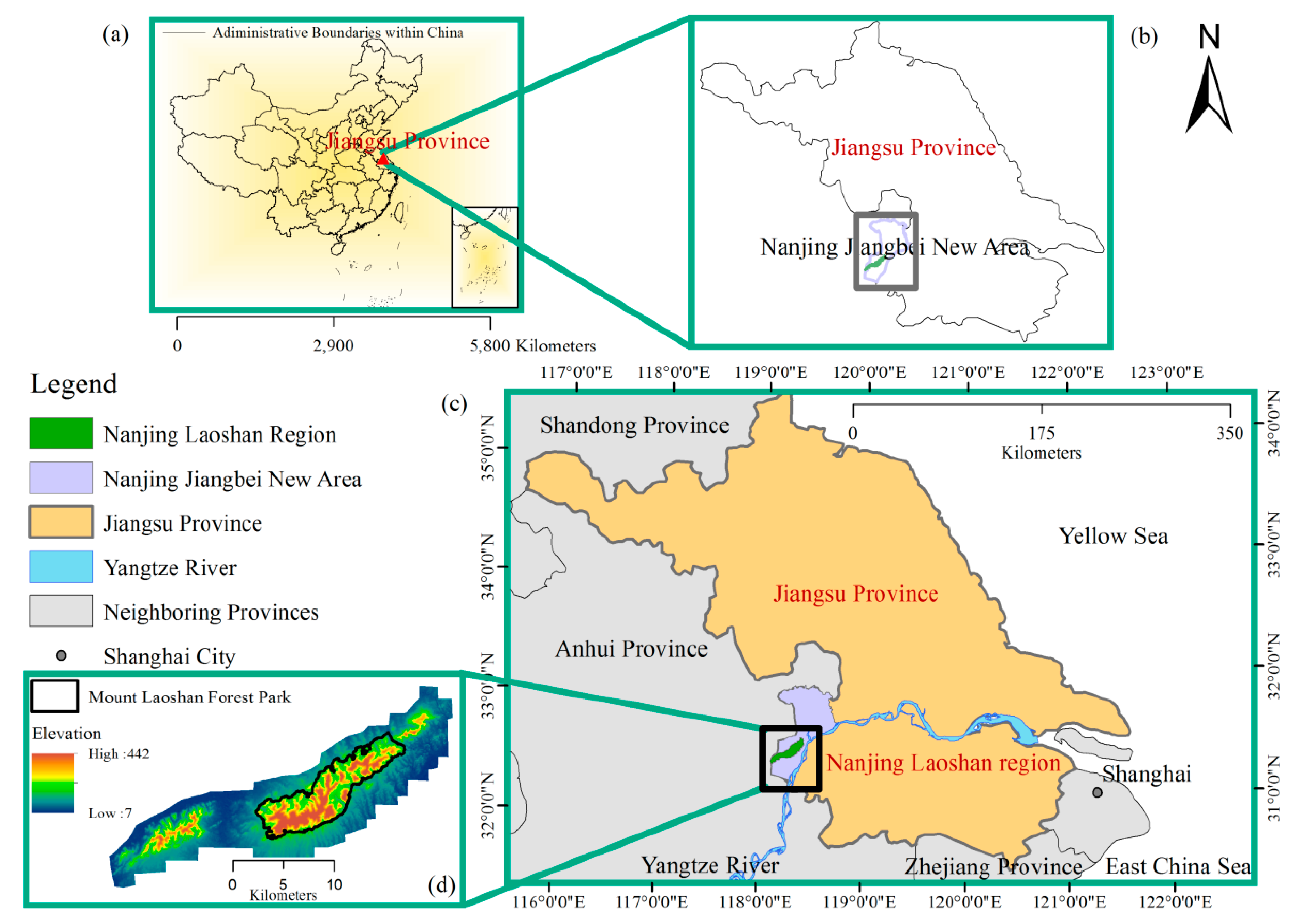
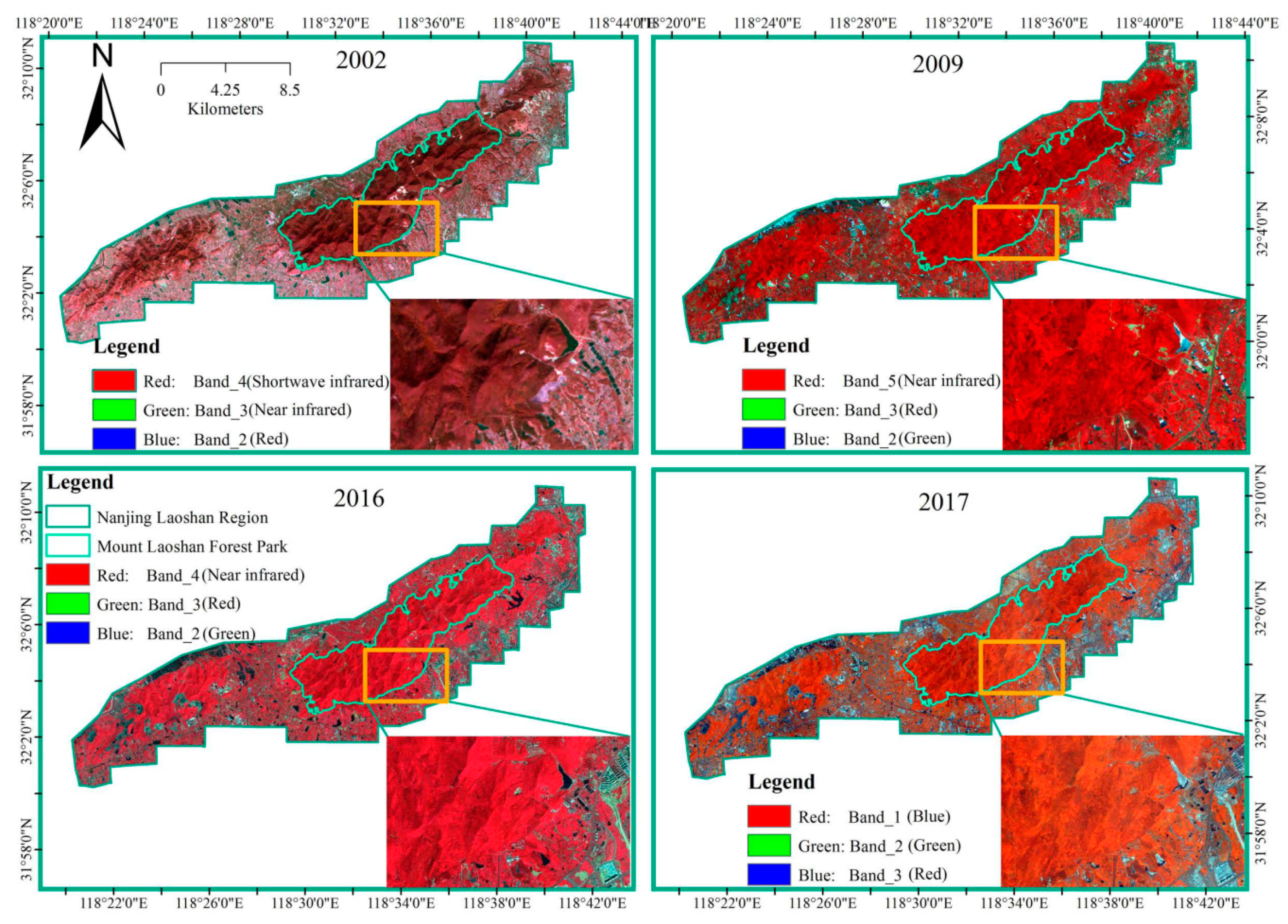
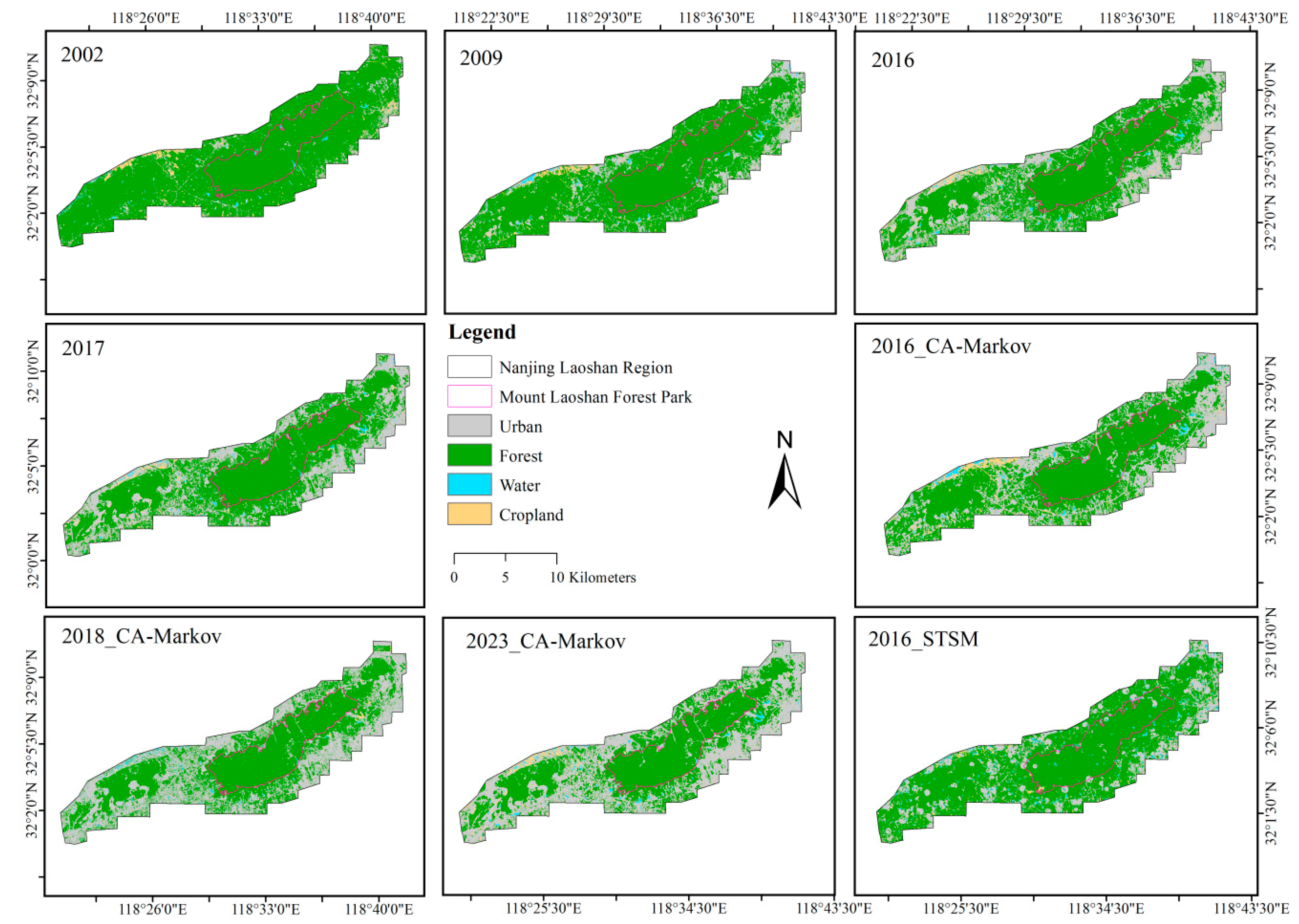
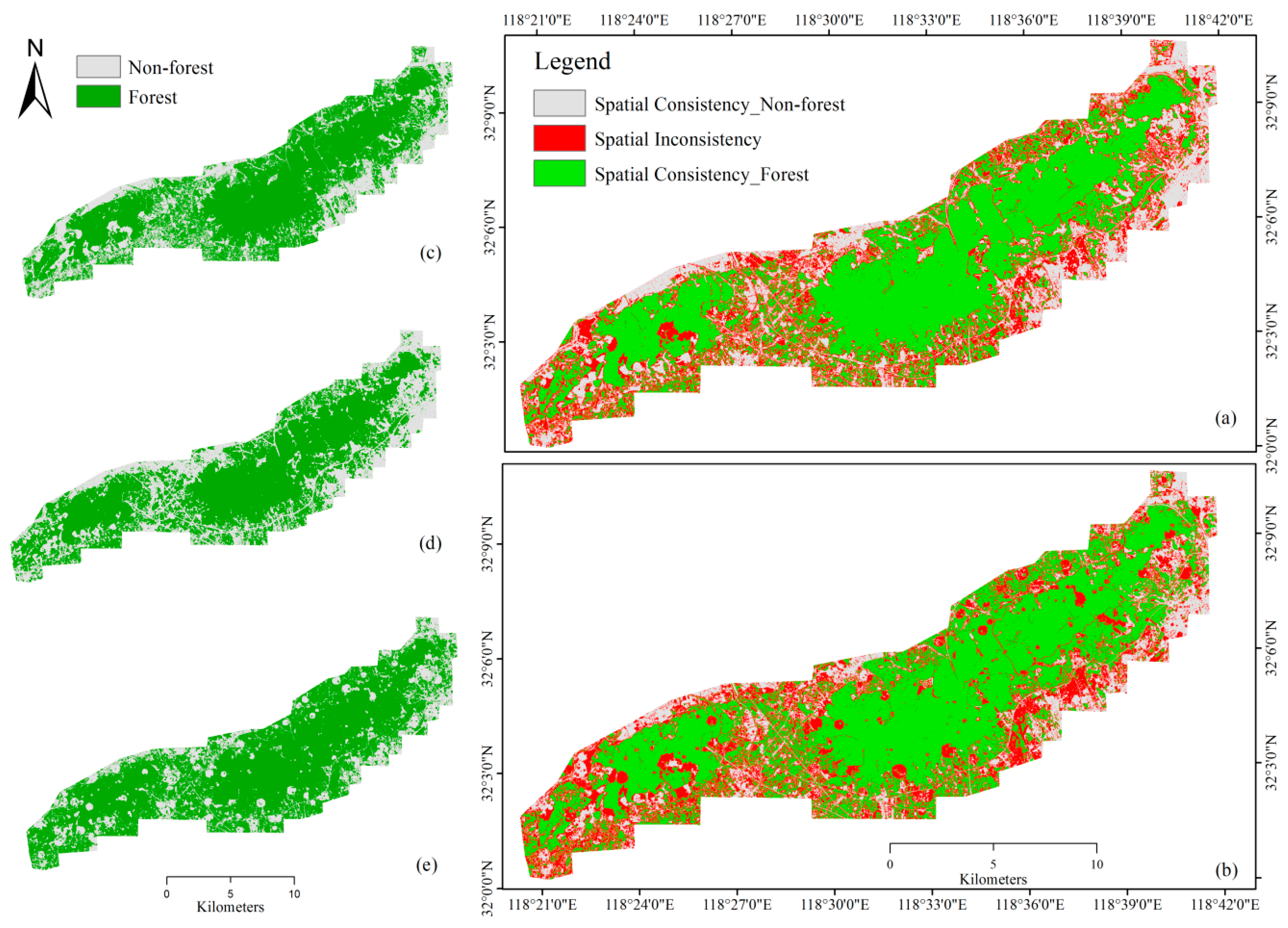
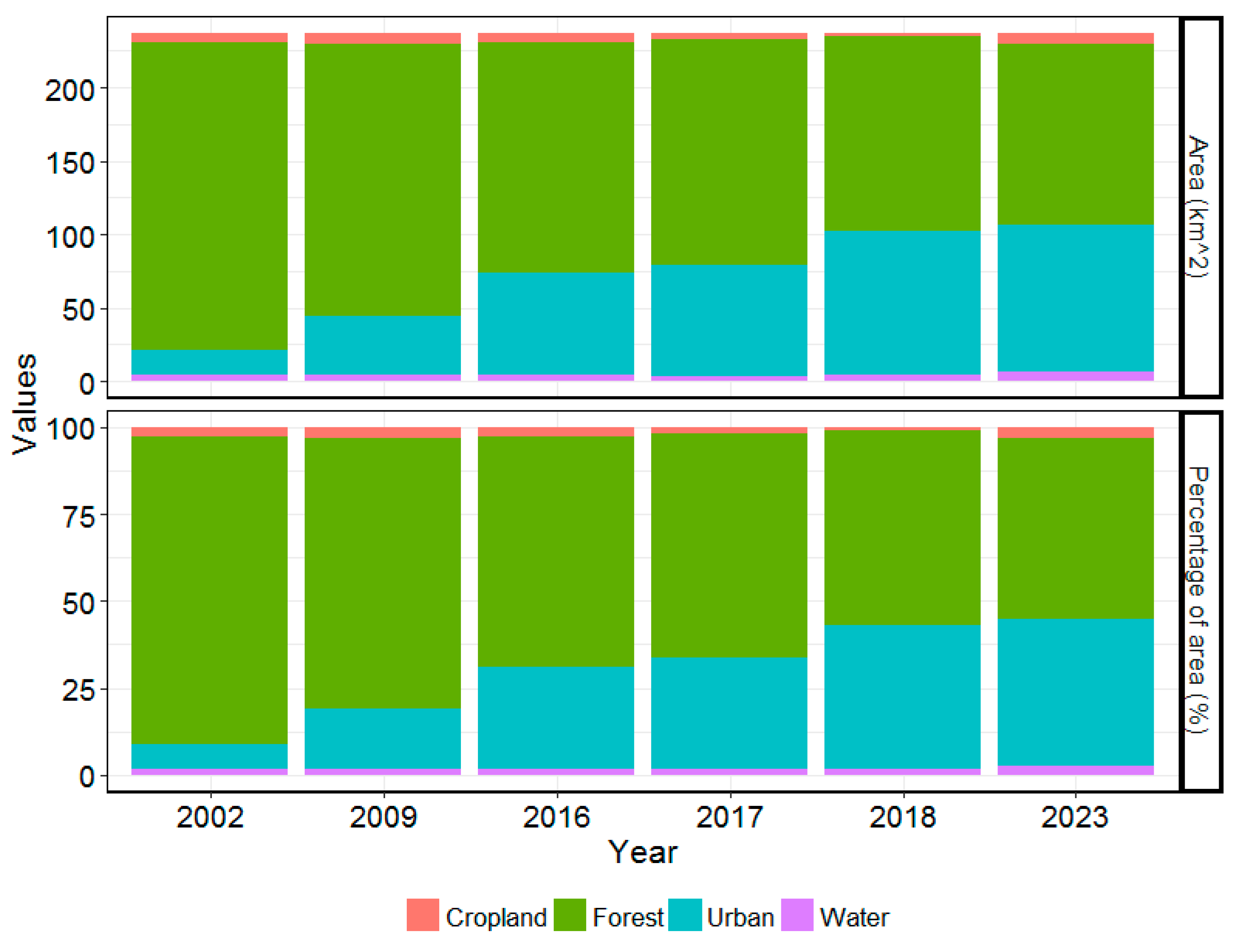
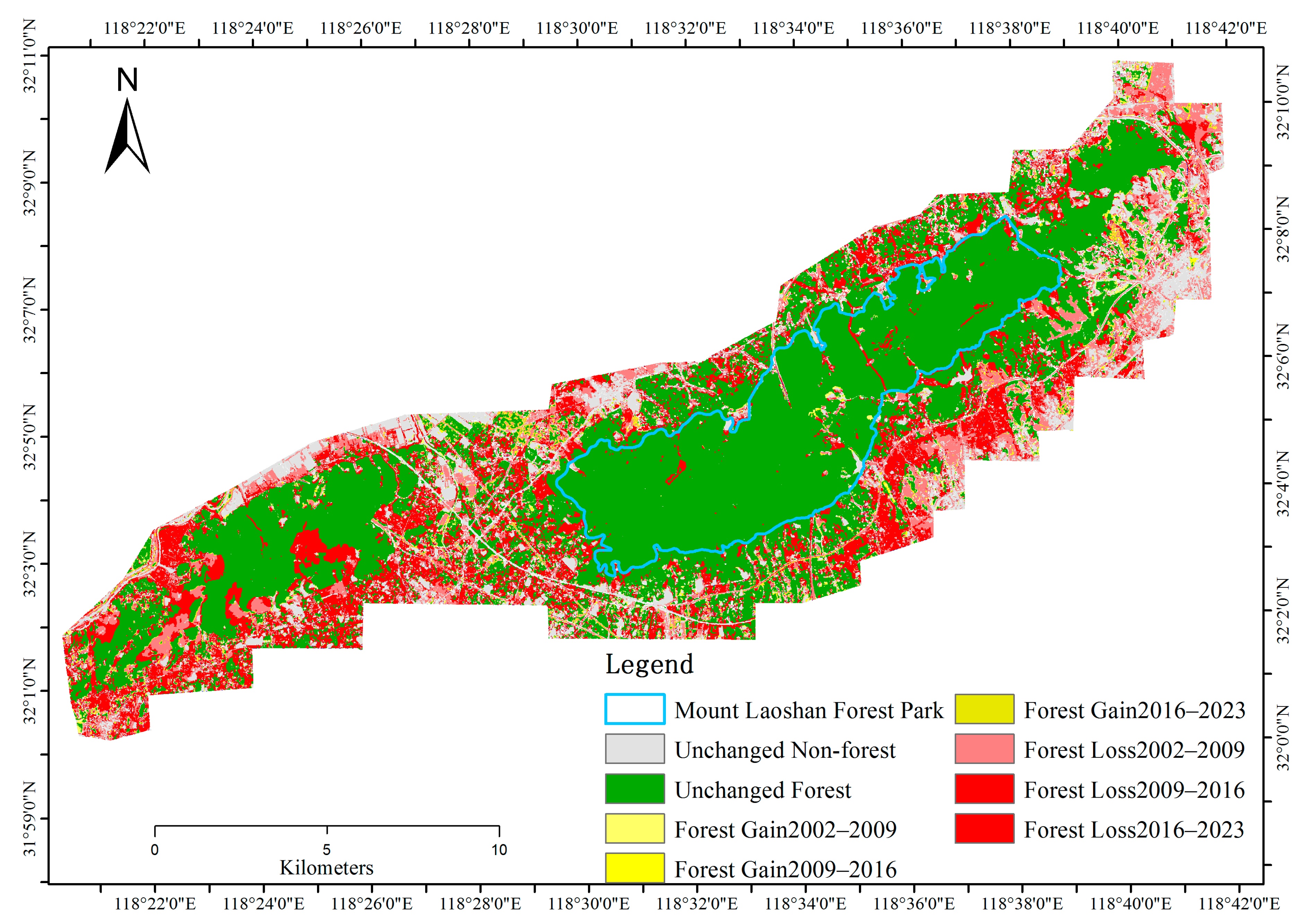
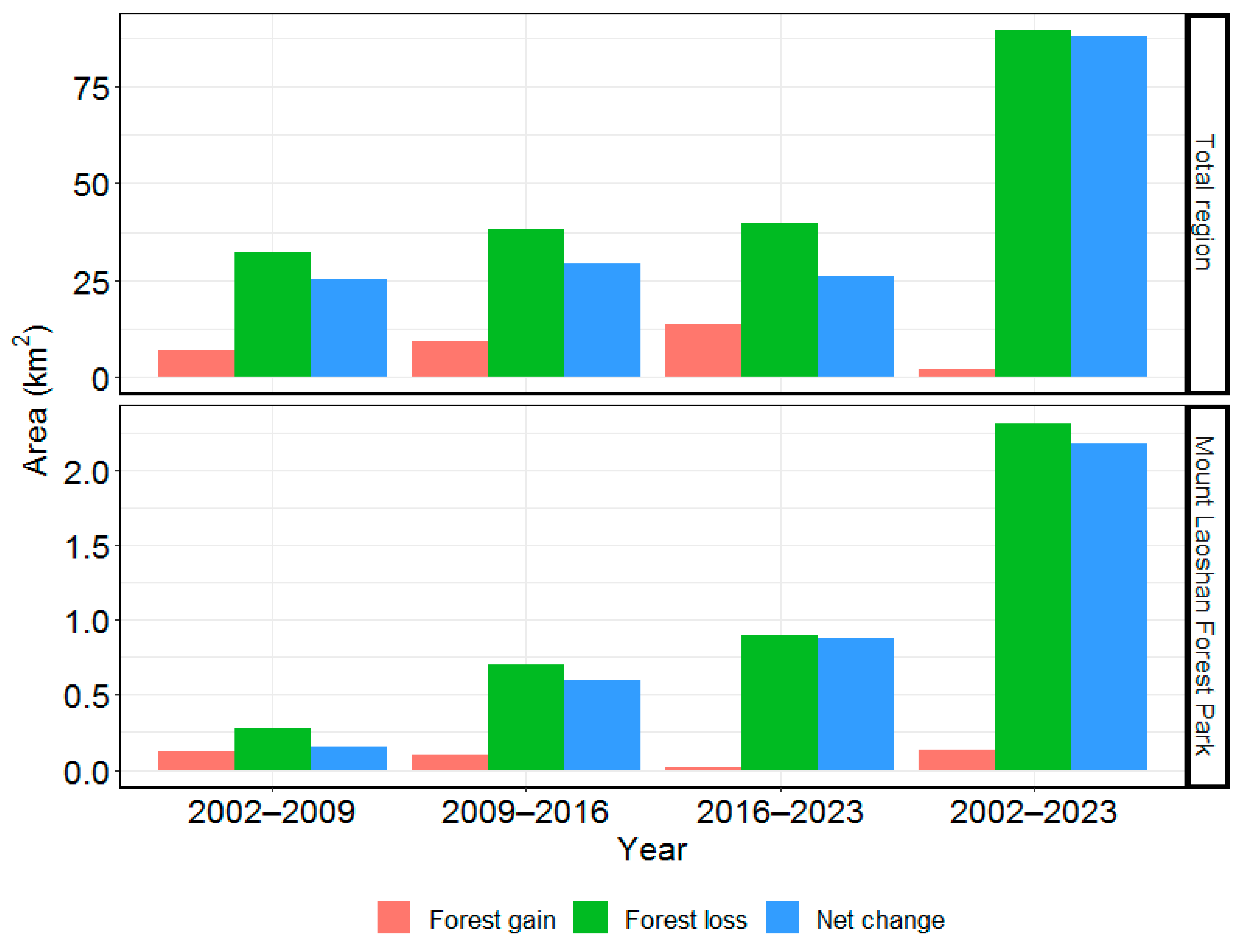

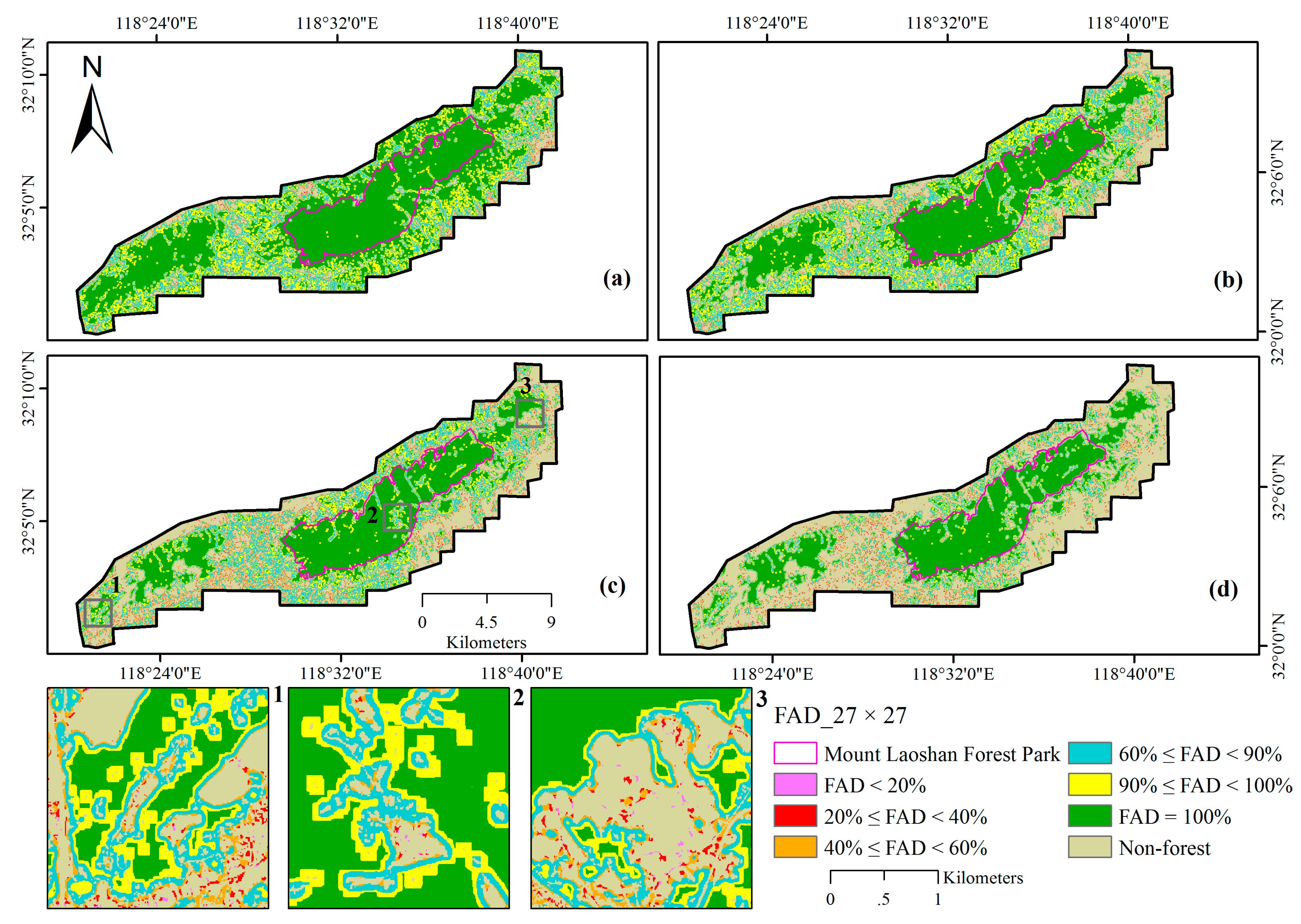
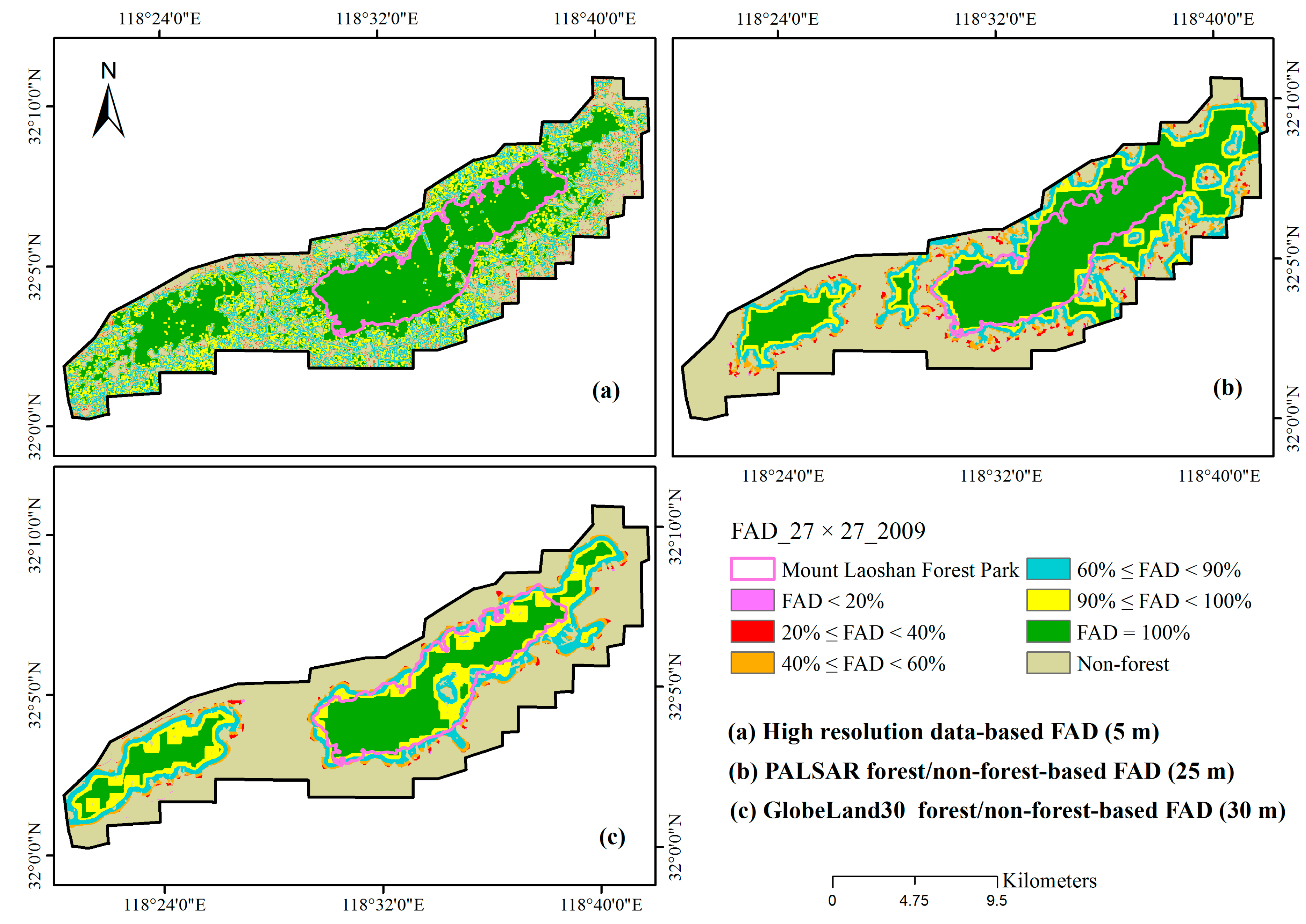
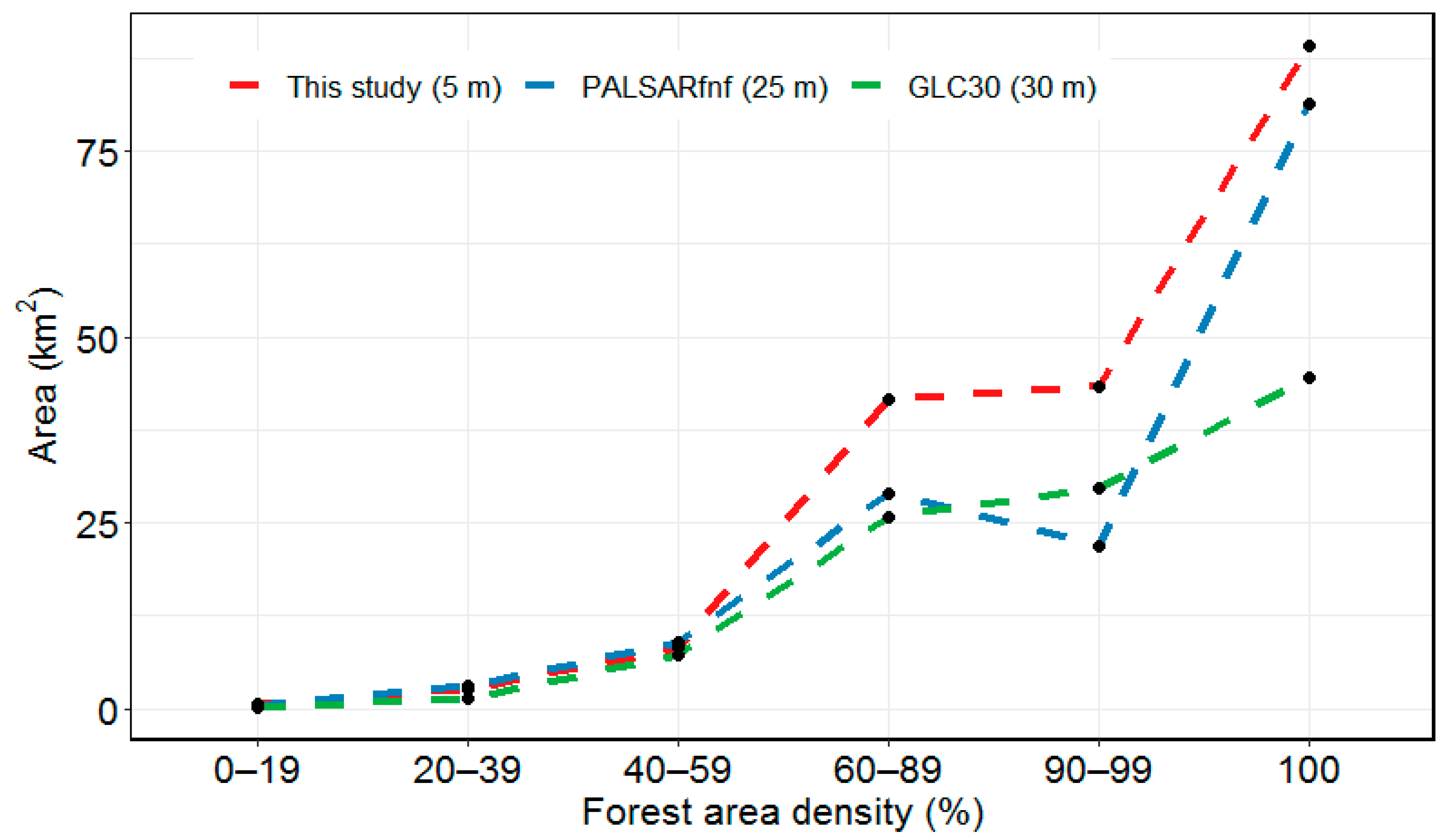
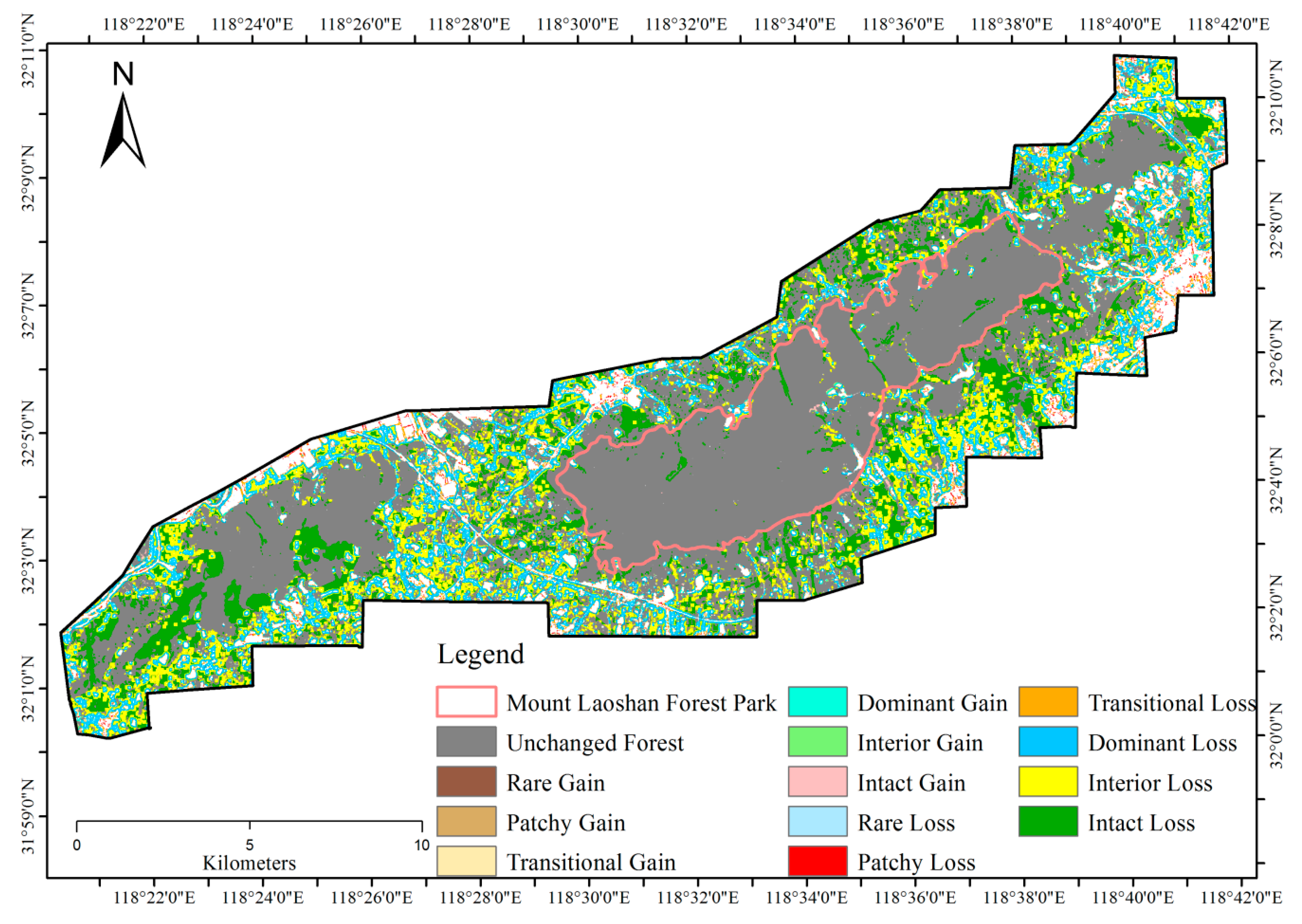
| Dataset | Date | Band | Resolution (Pan/Multispectral, m) |
|---|---|---|---|
| SPOT5 | 11/9/2002 | Pan, Green, Red, Near infrared, Shortwave infrared | 2.5, 10 |
| SPOT7 | 5/12/2016 | Pan, Blue, Green, Red, Near infrared | 1.5, 6 |
| RapidEye | 6/25/2009, 7/25/2017 | Blue, Green, Red, Red edge, Near infrared | non, 5 |
| Dataset | Image Composite | Spectral Detail | Spatial Detail | Minimum Segment Size | No. of ROIs |
|---|---|---|---|---|---|
| SPOT5 | Band 3, 2, 1 | 20 | 10 | 16 | 80 points per type (20 points for water) |
| SPOT7 | Band 4, 3, 2 | 20 | 10 | 16 | 80 points per type (20 points for water) |
| RapidEye | Band 5, 4, 3 | 18 | 10 | 12 | 80 points per type (20 points for water) |
| No. | FAD Class | FAD Range [44] | New FAD Range (This Study) | Fragmentation Level |
|---|---|---|---|---|
| 1 | Rare | FAD < 10% | 0 ≤ FAD < 20% | Highly fragmented |
| 2 | Patchy | 10% ≤ FAD < 40% | 20% ≤ FAD < 40% | Medium fragmentation |
| 3 | Transitional | 40% ≤ FAD < 60% | 40% ≤ FAD < 60% | Medium fragmentation |
| 4 | Dominant | 60% ≤ FAD < 90% | 60% ≤ FAD < 90% | Medium fragmentation |
| 5 | Interior | 90% ≤ FAD < 100% | 90% ≤ FAD < 100% | Limited fragmentation |
| 6 | Intact | FAD = 100% | FAD = 100% | Not fragmented |
| Products | Resolution | Forest Definition | Algorithms | Accuracy |
|---|---|---|---|---|
| PALSAR FNF | 25 m (PALSAR) | Canopy cover over 10%, and the area must be larger than 0.005 km2 | Backscatter thresholds | UA: 95.04%, PA: 81.51%, OA: 91.25% |
| GLC30 | 30 m (Landsat) | Canopy cover over 30% (including sparse woods over 10–30%) | MLC + Expert interpretation | UA: 83.58% OA: 80.33% |
| This study | 5 m (RapidEye) | Canopy cover over 10% | Object-oriented + SVM |
| 2002 | 2009 | 2016 | 2016 CA-Markov | 2016 STSM | 2017 | |
|---|---|---|---|---|---|---|
| Overall accuracy | 83.75% | 90.85% | 90.30% | 69.40% | 54.95% | 92.25% |
| Kappa coefficient | 0.78 | 0.88 | 0.87 | 0.59 | 0.39 | 0.90 |
| Year | Forest Area for Two Dates (km2) | Annual Deforestation Area (km2 yr−1) | Annual Deforestation Rate (% yr−1) |
|---|---|---|---|
| 2002–2009 | 209.4, 185.3 | 3.45 | 1.57 |
| 2009–2016 | 185.3, 157.1 | 4.03 | 2.04 |
| 2016–2017 | 157.1, 153.1 | 4.01 | 2.6 |
| 2016–2023 | 157.1, 123.9 | 4.75 | 2.78 |
| 2018–2023 | 133.1, 123.9 | 1.85 | 1.35 |
| 2002–2023 | 209.4, 123.9 | 4.07 | 1.64 |
| Year | 0–19% | 20–39% | 40–59% | 60–89% | 90–99% | 100% | ≥90% |
|---|---|---|---|---|---|---|---|
| 2002 | 0.1 | 0.6 | 2.3 | 15.9 | 23.7 | 57.4 | 81.1% |
| 2009 | 0.3 | 1.3 | 4.4 | 22.5 | 23.3 | 48.2 | 71.5% |
| 2016 | 0.7 | 2.9 | 8.0 | 25.5 | 18.1 | 44.8 | 62.9% |
| 2017 | 0.9 | 3.3 | 7.8 | 23.9 | 17.7 | 46.4 | 64.1% |
| 2018 | 3.1 | 6.3 | 9.1 | 21.9 | 12.1 | 47.5 | 59.6% |
| 2023 | 1.4 | 3.7 | 8.5 | 21.0 | 12.1 | 53.3 | 65.4% |
| %Net Change | Forest Interior and Intact (%) | Total Forest Area (%) | Ratio |
|---|---|---|---|
| 2002–2009 | −14.19 | −12.16 | 1.17 |
| 2009–2016 | −18.28 | −15.97 | 1.15 |
| 2016–2023 | −18.57 | −17.66 | 1.05 |
| 2002–2023 | −43.44 | −41.9 | 1.04 |
© 2020 by the authors. Licensee MDPI, Basel, Switzerland. This article is an open access article distributed under the terms and conditions of the Creative Commons Attribution (CC BY) license (http://creativecommons.org/licenses/by/4.0/).
Share and Cite
Shen, W.; Mao, X.; He, J.; Dong, J.; Huang, C.; Li, M. Understanding Current and Future Fragmentation Dynamics of Urban Forest Cover in the Nanjing Laoshan Region of Jiangsu, China. Remote Sens. 2020, 12, 155. https://doi.org/10.3390/rs12010155
Shen W, Mao X, He J, Dong J, Huang C, Li M. Understanding Current and Future Fragmentation Dynamics of Urban Forest Cover in the Nanjing Laoshan Region of Jiangsu, China. Remote Sensing. 2020; 12(1):155. https://doi.org/10.3390/rs12010155
Chicago/Turabian StyleShen, Wenjuan, Xupeng Mao, Jiaying He, Jinwei Dong, Chengquan Huang, and Mingshi Li. 2020. "Understanding Current and Future Fragmentation Dynamics of Urban Forest Cover in the Nanjing Laoshan Region of Jiangsu, China" Remote Sensing 12, no. 1: 155. https://doi.org/10.3390/rs12010155
APA StyleShen, W., Mao, X., He, J., Dong, J., Huang, C., & Li, M. (2020). Understanding Current and Future Fragmentation Dynamics of Urban Forest Cover in the Nanjing Laoshan Region of Jiangsu, China. Remote Sensing, 12(1), 155. https://doi.org/10.3390/rs12010155









